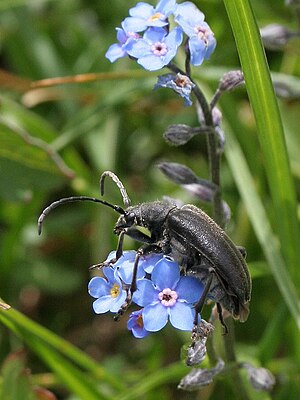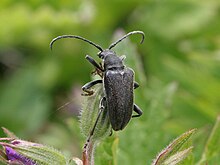Black ball neck
| Black ball neck | ||||||||||||
|---|---|---|---|---|---|---|---|---|---|---|---|---|

Black spherical collar ( Acmaeops septentrionis ) at Rochers de Naye , Switzerland |
||||||||||||
| Systematics | ||||||||||||
|
||||||||||||
| Scientific name | ||||||||||||
| Acmaeops septentrionis | ||||||||||||
| ( CG Thompson , 1866) |
The Black Ball neck Bock ( Acmaeops septentrionis ) is a beetle from the family of longhorn beetles (Cerambycidae). It is one of six species of its genus , of which four other species occur in Europe .
features
Characteristics of the adults
The black ball collar reaches a body length of 7.9 to 9 millimeters. The body is built generically typical and has a ball-like pronotum with a strongly curved pronotum . The elytra are variable in their color and can be yellowish-brown, but they are often black, sometimes with a yellow outer edge. They are lightly haired and strongly and densely dotted; they are rounded at the top and the outside angle is rounded or rectangular. The cheeks in front of the eyes are hardly longer than half the diameter of the eyes.
Characteristics of the larvae
The larvae of the genus reach a length of 11 to 19 millimeters; the body and head are clearly flattened. The antennae are short and tripartite; the second antenna element is extremely small and unsclerotized. There are 2 or 3 small stemmata on either side of the head capsule . The maxillae are slender and the malae have a broad, obliquely pigmented band. The abdominal sclerites of the abdominal segments have no bristles and the ninth abdominal segment does not have a caudal spine at the end of the body.
distribution
The black spherical collar is a Siberian element of fauna and occurs in northern to central Europe as well as in Russia (Siberia), Mongolia , China and Korea . In Central Europe there is an extinction zone that divides the distribution areas into a northern area in Scandinavia and a southern area in Central Europe. There is no evidence in Denmark , the Netherlands , Luxembourg and Belgium . In Germany the species is only documented in Bavaria , Thuringia , Saxony and Mecklenburg-Western Pomerania , whereby the population in Mecklenburg-Western Pomerania is an autochthonous species . In Austria it is known from several federal states, in Switzerland it is also widespread. As a boreomontane species, it occurs in Central European mountains at altitudes of around 1000 meters; however, it lives in valleys in the Elbe Sandstone Mountains , and the occurrences in Mecklenburg-Western Pomerania and Saxony are atypical for a highland species.
Way of life
The black ball-necked buck lives mainly in coniferous forests and clearcuts . The adults can be found from June to July, regionally also from May to August. They are diurnal and can be found on wood and flowering vegetation. The beetles fly over fields and piles of spruce trees, especially in sunshine. You will visit the flowers of umbellifers (Apiaceae) such as angelica ( Angelica ), but also on rowanberry ( Sorbus aucuparia ) and spear bushes ( Spiraea ).
The species is oligophagous and develops in spruce ( Picea ), pine ( Pinus ) and, more rarely, larch ( Larix ). The larvae take two years to develop. They usually develop in drying wood stumps and trunks, especially in wood residues left behind after wind or snow breakage, as well as in wood damaged by fire. In Saxony, larvae from spruce stakes on wooden fences in game enclosures are known. In addition, the adults were found on cordwood and felled trunks. The eggs are laid on the bark. The larvae feed on the inner bark and later invade the bark. To pupate , they leave the wood and dig into the upper humus layer , where they form small chambers a few centimeters below the surface. Pupation takes place less often in the bark.
Systematics
The black buck ball neck is a separate type of longhorn beetles (Cerambycidae), where it is in the genre of the ball neck blocks ( Acmaeops LeConte 1850 ) within the narrow blocks classified (Lepturinae). The first scientific description comes from the Swedish entomologist Carl Gustaf Thomson , who described it in 1866. In addition to this species, the genus contains five other species. Acmaeops alpestris Pic , 1898 , is mentioned as a synonym .
The name for the genus is derived from the Greek " akmaios " for "blooming" or "strong" and from " ops " for "eye". The epithet " septentrionis " comes from Latin and means "occurring in the north".
supporting documents
- ↑ a b c d e f g h i j k l m "Type: Acmaeops septentrionis (CG Thompson, 1781) - Black Ball Neck." In: Bernhard Klausnitzer, Ulrich Klausnitzer, Ekkehard Wachmann, Zdeněk Hromádko: Die Bockkäfer Mitteleuropas . Die Neue Brehm-Bücherei 499, Volume 2, 4th edition. VerlagsKG Wolf, Magdeburg 2018, ISBN 978-389432-864-1 ; Pp. 378-379.
- ↑ "14. Genus: Acmaeops Lec. “In: Edmund Reitter : Fauna Germanica. The beetles of the German Empire. KG Lutz, Stuttgart 1912; P. 10. ( digitized version )
- ↑ a b Bernhard Klausnitzer, Ulrich Klausnitzer, Ekkehard Wachmann, Zdeněk Hromádko: The longhorn beetles of Central Europe . Die Neue Brehm-Bücherei 499, Volume 1, 4th edition. VerlagsKG Wolf, Magdeburg 2018, ISBN 978-389432-864-1 ; Pp. 105-107
- ↑ a b Acmaeops septentrionis. Fauna Europaea, accessed June 22, 2020 .
literature
- "Species: Acmaeops septentrionis (CG Thompson, 1781) - black spherical neck buck." In: Bernhard Klausnitzer, Ulrich Klausnitzer, Ekkehard Wachmann, Zdeněk Hromádko: The longhorn beetles of Central Europe . Die Neue Brehm-Bücherei 499, Volume 2, 4th edition. VerlagsKG Wolf, Magdeburg 2018, ISBN 978-389432-864-1 ; Pp. 378-379.
